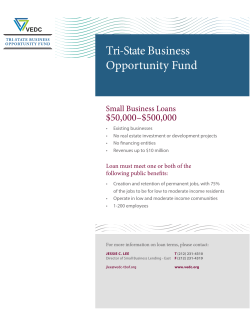
Growth Loans Market Gap
Growth Loans Market Gap Analysis Methodology Note Introduction This note provides an overview of the methodology, data sources and assumptions used to derive the Growth Loans market gap estimates presented in the British Business Bank Research Report “Analysis of the UK Smaller Business Growth Loans Market”. The overall approach taken estimates the potential level of demand for growth loans from SMEs seeking finance and then subtracts the actual supply of growth loans in 2014 to provide an estimate of the potential funding gap. These figures are indicative estimates only, and are based on the best data currently available. They show potential latent demand, and should not be used to give an indication of the actual number of applications. Demand The primary qualitative research undertaken with growth loan providers revealed a set of broad characteristics that make companies potentially suitable for a growth loan. These included: o Businesses older than 3 years (in order to be an established business with a track record and not be a start-up business with higher risk profile) o 3 year average annual growth rate of between 5-20% per annum (in order to have demonstrated positive growth and be classed as a potentially viable business1). o Annual turnover in the range £1m to £25m (in order for the business to be of sufficient size to receive a growth loan and fit the definition of an SME). Using Companies House data via the FAME2 on line database administered by Bureau van Dijk, the number of businesses in the UK population meeting all of these criteria was selected. Where company turnover figures were missing, FAME was able to provide an estimate of the missing data using regression analysis from companies with similar characteristics.3 This led to around 16,000 businesses being identified: Turnover Band From £1m to £5m 6,010 From £5m to £10m 3,824 From £10m to £15m 3,177 From £15m to £20m 1,936 From £20m to £25m 1,291 All 1 Number of Companies4 16,238 A growth rate of above 20% is defined as being high growth under the OECD’s definition of a high growth business. It is assumed these businesses may be more suitable for equity finance. 2 FAME is a database of all registered companies in the UK covering information on their financial balance sheet, directors, financial strength including credit scores and CCJs, shareholders and corporate structure. The information is from Companies House data, but requires a subscription to access this service. See https://fame.bvdinfo.com/ 3 For smaller companies it is not a legal requirement to provide information on turnover when filing annual accounts, but many businesses choose to do so. Only around 10% of the businesses required a derived turnover figure (equivalent to 1,600 businesses). 4 Due to licensing restrictions it is not possible for British Business Bank to provide a list of the names of the 16,000 businesses identified to third parties, but organisations can subscribe to FAME or other data suppliers like Experian to undertake similar analysis. 5 Not all of the 16,000 businesses will be seeking external finance at any point in time and, of those that do seek finance; most will be able to obtain finance from senior debt providers. The SME Finance Monitor Survey5 was used to provide an estimate of the proportion of businesses seeking term loans and having difficulties obtaining them. It is assumed that in most cases businesses will try to obtain senior debt in the first instance due to its lower cost, rather than approaching a growth loan provider first. The British Business Bank used the raw survey dataset6 to assess the demand and ability of businesses in the target market to obtain senior debt finance.7 The specific characteristics used to match the types of business identified as being in the target market as being suitable for a growth loan included: o Businesses with turnover greater than £1m o Businesses older than 2 years (3 years was not available) o Businesses aiming to grow in next year (so as to be in line with the types of business seeking growth loans) In the Q2 2014 dataset, only 73 respondents met all these criteria. Whilst this is a small number of respondents on which to undertake statistically robust analysis, the derived proportions were similar to analysis undertaken previously using a different quarter’s data. This gives confidence in the broad range of the figures, although these figures are not statistically significant and should only be used to give an indication. Of the businesses with the selected characteristics, 6% had sought a term loan in the previous 12 months. Scaling this to the total population of suitable businesses in the target market (16,000) suggests that around 970 businesses sought a term loan. Of those businesses seeking a term loan, around 60% obtained senior debt funding, whilst 40% were refused or had difficulties obtaining this finance. This left around 390 businesses with the identified characteristics not being able to obtain senior debt finance. The proportion of businesses that were discouraged from seeking finance was derived in a similar manner from SME Finance Monitor data using the same target characteristics. Whilst 4.6% of all businesses with these characteristics were discouraged (750), it is assumed that the launch of growth loans (and the associated promotional campaign and media coverage) will encourage up to 10% of the discouraged population to seek a growth loan directly, which is equivalent to 75 businesses. Therefore, by adding the 390 businesses declined senior debt finance to the 75 discouraged businesses that might now seek a growth loan directly gives an estimated 465 businesses likely to be seeking growth loans over a 12 month period. However, there remains some uncertainty on the value of individual growth loans being sought, and the extent to which they will include senior debt funding as opposed to being solely mezzanine transactions. Therefore a number of scenarios were presented with the individual growth loans available ranging in value from £500k up to £5m. The number of businesses likely to be seeking The SME Finance Monitor Survey is an independent quarterly survey of 5,000 SMEs undertaken by BDRC Continental asking SMEs about their experience seeking loans or overdrafts from a bank. http://bdrc-continental.com/products/sme-finance-monitor/ 6 Using SPSS statistical software to filter and aggregate individual respondents’ answers. 7 Although the SME Finance Monitor report is made publically available on the SME Finance Monitor Website, the SPSS dataset is only available on request from BDRC Continental or the ESRC Data Archive for academic research. growth loans (465) was multiplied by the assumed growth loan deal size to give the estimated value of market demand. Supply In early 2015, the British Business Bank contacted a number of funds and other SME-focused growth loan providers operating in the sub-£5m space to identify the number of growth loans made in 2014 calendar year. A distinction was made for funds that targeted deal sizes up to £2m and those providing up to £5m.8 The qualitative research also revealed that VCTs have a large impact on the SME growth loan market. Current VCT rules9 allow up to 30% of VCT investments to be structured as debt or mezzanine. The number of VCT investments made per year is not known and so the amount of new VCT fundraising is used as a proxy for the amount of new investment. It is assumed that 30% of the £440m raised in 2013/2014 went towards growth loans (£130m). VCT investments are included within the sub-£5m deal size category, as they are able to invest up to £5m per business. AIC research10 confirms the average size of VCT investment per business is £2.8m, which supports the assumption. It is not possible for the British Business Bank to provide a breakdown of individual fund investments undertaken in 2014, as this information was provided to the Bank in good faith on the basis that it would not be publicly disclosed. Aggregating the value of investments made across the existing growth loan providers and VCTs, the total supply of growth loans by providers targeting deals up to £2m is £60m, whilst for providers targeting up to £5m the total supply is estimated to be £260m in 2014. This is an estimate of total supply as there are likely to be other providers’ e.g. private lenders and other funds in this space that the British Business Bank is not currently aware of. Gap To estimate the size of the market gap, the estimate of supply was subtracted from estimate of potential demand to give an estimate of the funding gap for each of the deal size scenarios. The current gap is estimated to be relatively small due to the low demand for external finance overall, but it liable to increase in the future as business demand for external finance increases from its current low levels. The gap is estimated for the UK overall. It is not possible to accurately disaggregate the data across different regions or sectors. Market Insight Team British Business Bank 2nd April 2015 8 In practice some of the funds that target £5m growth loans will make loans below £2m, and so this is an approximate distinction. Some growth loan providers also supply senior debt alongside the growth loan tranche, but this is excluded from the figures to avoid inflating the supply. 9 http://www.hmrc.gov.uk/guidance/vct.htm 10 AIC (2013) “Investing for the future” http://www.theaic.co.uk/sites/default/files/hidden-files/AICVCTInvestingfortheFutureMay13.pdf
© Copyright 2025









